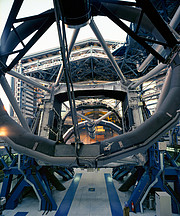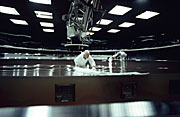Nota de Imprensa
Paranal Impressions
16 de Junho de 2000
The main construction phase at the ESO Paranal Observatory is now over and normal operations have begun with two of the four 8.2-metre Unit Telescopes, ANTU and KUEYEN. The next major event will be the installation of the first astronomical instrument, VIMOS (VIsible MultiObject Spectrograph), at the third telescope, MELIPAL. "First Light" for the fourth telescope, YEPUN will follow later this year. The present collection of 29 photos illustrates the current state of the VLT site. They have been divided by theme into five sections that may be accessed by clicking on the corresponding images above.
Technical Information
These photos were made by ESO photographer Hans Hermann Heyer in March 2000. Depending on the nature of the subject as well as the properties of the available photographic films, Leica M6, Hasselblad SWC, Linhof Technika 6x9 or Sinar 4x5" cameras were used. The objective focal length ranged from 21mm to 280mm, resulting in viewing angles from approximately 10° to 115°. Various Fuji and Kodak colour slide films with speeds from 18°/50 to 36°/3200 ISO/ASA were used. The reproductions shown here were scanned from the original films and image processed by the author.
A Home in the Desert
The Basecamp
The Basecamp is located below the Paranal mountain. It is centre of the daily life at Paranal, with the various service buildings, laboratories and offices, as well as dormitories for staff and visitors.
The new Paranal Residencia is now being constructed on the slope south of the Basecamp. When ready in 2001, it will house the offices and sleeping quarters. Some of the containers in the Basecamp will then be removed.
See images eso0021a, eso0021b, eso0021c
Night Falls at Paranal
Preparing for the Observations
Astronomical observations begin soon after sunset at Paranal.
Normally, they start with a series of test and calibration exposures that serve to determine the exact status of the various instruments, e.g., in terms of sensitivity at different wavelengths.
Some of these exposures are performed on a white target on the inside of the telescope enclosure, others are made on the sky, as it gets progressively darker.
If they are included in a programme, observations of comparatively bright objects may be carried out while the sky is still relatively bright. However, those of the faintest objects must wait until the period of "astronomical twilight" is over, i.e., when the Sun is at least 18° below the horizon.
See images eso0021d, eso0021e, eso0021f, eso0021g, eso0021h, eso0021i
Hub of the Observatory
The VLT Control Room
The Control Building is located on a "shelf" below the main observing platform at the top of the Paranal Mountain. It is the true hub of the Paranal Observatory and it is from here that the VLT telescopes and instruments are controlled by the observing teams. Daytime maintenance routines are also carried out by the ESO engineers via the computer terminals and monitors here.
Each of the four Unit Telescopes is controlled from a specific area (a "module") within the Control Room . From here, the night assistants, engineers and astronomers perform the observations. The work includes continuous monitoring and optimisation of the telescope status, pointing of the telescope towards the celestial objects to be observed, adjustments of the instrument (camera, spectrograph) before the exposures, as well as subsequent transfer and storage of the data from the instrument and a first evaluation of the results.
The fact that all work is done from a single room greatly facilitates the direct interaction between the different groups of observers.
See images eso0021j, eso0021k, eso0021l, eso0021m
A New Coat for a Large Mirror
Ensuring a Highly Reflecting Surface
Astronomical mirrors must be regularly coated in order to retain their ability to reflect light efficiently. Otherwise, too many of the sparse and precious photons collected from distant celestial objects may be lost, adversely influencing the observing programmes.
ANTU and KUEYEN, the two first VLT Unit Telescopes to enter into operation did so while construction work was still ongoing at the top of Paranal. During this period, there was unsually much dust in the air, some of which was deposited on the large mirrors of these two telescopes.
It was therefore decided to re-aluminize these mirrors when the work was over. This was done in February and March 2000.
For this delicate operation, the mirror cell with the 22-tonnes, 8.2-m Zerodur mirror is removed from the telescope and wrapped in a protective cover. It is then moved out of the telescope enclosure and placed on a carriage that is hauled down the mountain to the Mirror Maintenance Building (MMB).
Here the old aluminium layer is removed and the mirror is carefully washed, before it is placed in the Coating Tank. A new and clean aluminium layer is deposited by the sputtering technique. After careful checking, the mirror is brought back to the telescope and mounted.
The following photos were obtained at the time when KUEYEN's mirror was undergoing this process: eso0021n, eso0021o, eso0021p, eso0021q, eso0021r, eso0021s, eso0021t, eso0021u, eso0021v, eso0021w, eso0021x, eso0021y
KUEYEN Start-Up
Reinstallation of the Mirrors
Following the coating of the 8.2-m main mirror of KUEYEN , the mirror in its cell was returned to the telescope enclosure.
Here it was remounted on the telescope structure in a series of operations that involved, among others, the installation of the so called M3-tower in the central hole in the mirror. This structure supports the tertiary mirror (M3) that deflects the light towards the Nasmyth foci on the sides of the telescope.
Sobre a Nota de Imprensa
| Nº da Notícia: | eso0021 |
| Legacy ID: | Photo 15a-ac/00 |
| Nome: | Cerro Paranal, Panorama, Paranal, Very Large Telescope, VLT Unit Telescopes |
| Tipo: | Unspecified : Technology : Observatory Unspecified : Technology : Observatory : Facility Unspecified : Technology : Observatory : Telescope Unspecified : Technology : Observatory : Instrument |
| Facility: | Very Large Telescope |
Our use of Cookies
We use cookies that are essential for accessing our websites and using our services. We also use cookies to analyse, measure and improve our websites’ performance, to enable content sharing via social media and to display media content hosted on third-party platforms.
ESO Cookies Policy
The European Organisation for Astronomical Research in the Southern Hemisphere (ESO) is the pre-eminent intergovernmental science and technology organisation in astronomy. It carries out an ambitious programme focused on the design, construction and operation of powerful ground-based observing facilities for astronomy.
This Cookies Policy is intended to provide clarity by outlining the cookies used on the ESO public websites, their functions, the options you have for controlling them, and the ways you can contact us for additional details.
What are cookies?
Cookies are small pieces of data stored on your device by websites you visit. They serve various purposes, such as remembering login credentials and preferences and enhance your browsing experience.
Categories of cookies we use
Essential cookies (always active): These cookies are strictly necessary for the proper functioning of our website. Without these cookies, the website cannot operate correctly, and certain services, such as logging in or accessing secure areas, may not be available; because they are essential for the website’s operation, they cannot be disabled.
Functional Cookies: These cookies enhance your browsing experience by enabling additional features and personalization, such as remembering your preferences and settings. While not strictly necessary for the website to function, they improve usability and convenience; these cookies are only placed if you provide your consent.
Analytics cookies: These cookies collect information about how visitors interact with our website, such as which pages are visited most often and how users navigate the site. This data helps us improve website performance, optimize content, and enhance the user experience; these cookies are only placed if you provide your consent. We use the following analytics cookies.
Matomo Cookies:
This website uses Matomo (formerly Piwik), an open source software which enables the statistical analysis of website visits. Matomo uses cookies (text files) which are saved on your computer and which allow us to analyze how you use our website. The website user information generated by the cookies will only be saved on the servers of our IT Department. We use this information to analyze www.eso.org visits and to prepare reports on website activities. These data will not be disclosed to third parties.
On behalf of ESO, Matomo will use this information for the purpose of evaluating your use of the website, compiling reports on website activity and providing other services relating to website activity and internet usage.
Matomo cookies settings:
Additional Third-party cookies on ESO websites: some of our pages display content from external providers, e.g. YouTube.
Such third-party services are outside of ESO control and may, at any time, change their terms of service, use of cookies, etc.
YouTube: Some videos on the ESO website are embedded from ESO’s official YouTube channel. We have enabled YouTube’s privacy-enhanced mode, meaning that no cookies are set unless the user actively clicks on the video to play it. Additionally, in this mode, YouTube does not store any personally identifiable cookie data for embedded video playbacks. For more details, please refer to YouTube’s embedding videos information page.
Cookies can also be classified based on the following elements.
Regarding the domain, there are:
- First-party cookies, set by the website you are currently visiting. They are stored by the same domain that you are browsing and are used to enhance your experience on that site;
- Third-party cookies, set by a domain other than the one you are currently visiting.
As for their duration, cookies can be:
- Browser-session cookies, which are deleted when the user closes the browser;
- Stored cookies, which stay on the user's device for a predetermined period of time.
How to manage cookies
Cookie settings: You can modify your cookie choices for the ESO webpages at any time by clicking on the link Cookie settings at the bottom of any page.
In your browser: If you wish to delete cookies or instruct your browser to delete or block cookies by default, please visit the help pages of your browser:
Please be aware that if you delete or decline cookies, certain functionalities of our website may be not be available and your browsing experience may be affected.
You can set most browsers to prevent any cookies being placed on your device, but you may then have to manually adjust some preferences every time you visit a site/page. And some services and functionalities may not work properly at all (e.g. profile logging-in, shop check out).
Updates to the ESO Cookies Policy
The ESO Cookies Policy may be subject to future updates, which will be made available on this page.
Additional information
For any queries related to cookies, please contact: pdprATesoDOTorg.
As ESO public webpages are managed by our Department of Communication, your questions will be dealt with the support of the said Department.





























